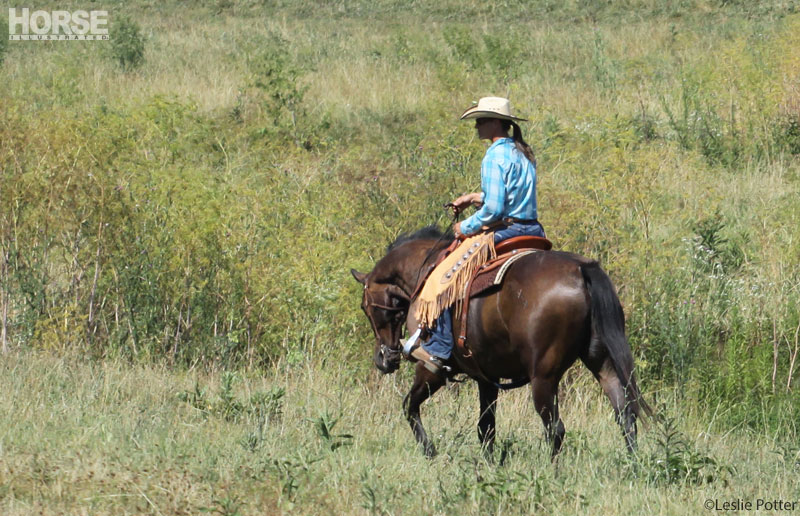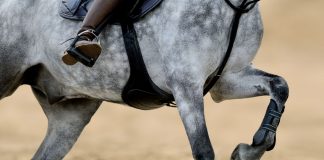
It’s a beautiful day and you are trotting along on your favorite horse enjoying the harmonious feeling. And, then suddenly he stumbles and you are unsettled in the saddle. Puzzled, you realize that this has been happening more often than not of late. What could be the problem?
Horses stumble or trip for a plethora of reasons. Some are simply distracted or too lazy to pick up their feet, especially on uneven terrain. Some trip even on a flat surface with not a grass sprig or root in sight. Correcting your horse’s focus is something you can work on with training and exercises to interest his attention. Change the routine, change the exercises, add in cavalletti or ground poles, or ride him out on the trail instead of only doing arena work. Surprise your horse with a mixture of activities to spark his interest.
Stumbling isn’t always just due to sheer laziness. A horse that travels with his head in the air, often referred to as “upside down” (the lower neck muscles bow towards the ground rather than making a nice upward arch), is a horse whose front and rear ends are poorly connected. This type of disconnected movement makes his locomotion so much less efficient that he is likely to trip. In some cases, the horse moves in an upside down frame due to poor saddle fit.
For any horse experiencing a poor-fitting saddle, the horse’s back may be sore enough to alter his gait, and this causes him to stumble. Your veterinarian can evaluate the back for pain and determine changes that may be needed to make your saddle fit more comfortably. Working with a qualified saddle fitter is the next step once you have a firm veterinary diagnosis that this is the problem.
On that same note, it is important for the rider to sit squarely in the saddle rather than tipping to one side or leaning forward too much. A horse that has to compensate for the rider’s imperfect balance has a harder time keeping himself upright, as well. This can lead to muscle fatigue or soreness, either of which can cause stumbling. So, work on your own equitation skills to help your horse move most efficiently.
Despite you doing everything right, some horses are simply klutzy or have poor conformation, making them less than agile on their feet. Just because a horse has “4-wheel drive” doesn’t necessarily make him an athlete. This lack of sure-footedness is something you can help him with by keeping him in a more collected frame rather than allowing him to sprawl out as you ride.
Muscle strength is important for your horse to carry you on his back while still controlling his own body. Poor neuromuscular coordination can arise from lack of muscle tone development. The solution to this may be as simple as getting him out of the stall and paddock and putting his muscles to work. One strategy you may already be doing involves turning the horse out into large areas where he can roam about the property honing his neuromuscular acuity. Another relies on skill sets you teach him over cavalletti poles, up and down hills and through other riding exercises that challenge his neuromuscular system to learn agility. Practice and training should produce steady improvement.
A horse that is poorly conditioned for the task being asked may be fatigued enough to lose the muscular strength necessary to pick up his feet. You can certainly do your conditioning homework to improve this situation and remember not to over-face him during athletic pursuits. Know when to call it a day so neither of you get hurt.
Medical Reasons for Stumbling
There are other medical reasons for stumbling that are more insidious and should be investigated by your veterinarian.
- Long toes are commonly known to cause stumbling, with or without run-under heels. This is because long toes increase the lever arm of the hoof, causing the horse a greater effort to pick up his heel, rotate over the toe as the hoof leaves the ground – referred to as breakover – and then set it down. The more difficult it is for the hooves to breakover, the more likely it will be that the horse will stub his toe into the ground and stumble. This can be corrected with regular farrier care in consultation with your vet.
- Foot pain can lead to stumbling. Protecting painful areas of the foot alters the gait, breakover and hoof strike to the ground, increasing the possibility of stumbling. Trimming and shoeing abnormalities or an infrequent farrier schedule can contribute to foot pain, especially in the heels.
Foot pain also develops due to trauma or degenerative disease conditions. Navicular disease, corns, a brewing hoof abscess, and stone bruises are all issues that contribute to a horse not wanting to pick up his feet as much as necessary. Stumbling is a common complaint voiced by owners of horses with heel soreness or navicular disease in addition to the horse having a shortened stride and a shuffling gait as his heels become more uncomfortable. Your veterinarian can help determine whether the foot pain is caused by an acute problem like a bruise or abscess or something more chronic like navicular disease. Once there is an accurate diagnosis, solutions and therapies can be applied to improve your horse’s comfort.
- Osteoarthritis, such as ringbone (high or low) or arthritis in the carpus (knee) may cause pain, lameness, or may create poor range-of-motion within the affected joint. Related gait alterations cause stumbling. Veterinary evaluation and radiographs (x-ray imaging) can identify these problems. Solutions include pain management and farrier work tailored to the horse’s musculoskeletal issue.
- Neurological problems have wide-ranging effects on locomotion and gait efficiency. These concerns range in severity from mild to significant: Wobbler syndrome, equine protozoal myelitis, West Nile virus, or trauma to the spine in the back or neck, to name a few. Identification of a neurologic problem requires a thorough veterinary evaluation.
Whatever the reason for the stumbling, it is important to track it down through a diligent process of elimination. This should involve your veterinarian who can then make recommendations on the best course of action to minimize your horse’s problem. You don’t want to see your horse go from stumble to tumble since that doesn’t bode well for either one of you. It is important not only for your horse to be comfortable but also to minimize the risk of your being unseated or thrown from the saddle. Then, you can ride with confidence and enjoy the harmony between you on your horse.
Liked this article? Here are others you’ll enjoy:
Ask the Vet: Why Does My Horse Stumble?
Try This: Riding Over Raised Poles






This is an excellent article. I used to worry about my QH Cadillac Kent. He would trip in the arena and once even went to his knees. Then I took him on a trail ride where the terrains was uneven. Winding trails, lots of roots, with some steep areas. He was like a mountain goat. He was just bored with the arena and dragging his toes in the sand..
My horse stumbled for years and it was finally diagnosed as equine protozoal encephalitis. On our last ride, he fell all the way down. I wish the vet had thought to test him years ago. Maybe I’d still be able to ride him if he had been treated earlier. He is retired now die to muscle and nerve atrophy from “EPM”.
Good article. In my horses case I have found 2 reasons. First, she is getting tired. Two time for a trim.
Great tips. My horse stumbles when he’s not paying attention.
My horse is lazy! He does the same thing at turnout as a casual walk under saddle, but get him interested in a planned activity and he’s a whole different horse!
I had a horse that stumbled and it turned out to be navicular disease